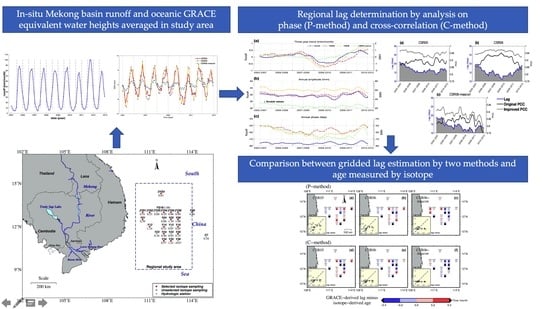GRACE-Derived Time Lag of Mekong Estuarine Freshwater Transport in the Western South China Sea Validated by Isotopic Tracer Age
Abstract
1. Introduction
2. Study Area and Data Description
2.1. Mekong River Estuary and Western SCS
2.2. Oceanic EWH Time Series from GRACE
2.3. Mekong Basin Runoff from In Situ Hydrological Stations
2.4. Isotope-Derived Age Based on Radium Isotope Data Measured in 2007
3. Methodology
3.1. Phase Analysis (P-Method)
3.2. Cross-Correlation Analysis (C-Method)
4. Results
4.1. Regional Study Results by Phase Analysis (P-Method)
4.2. Regional Study Results by Cross-Correlation Analysis (C-Method)
5. Discussion
5.1. Gridded GRACE-Derived Time Lag Estimation by Two Methods
5.2. Comparison between GRACE-Derived Time Lag and Isotope-Derived Age
6. Conclusions
Author Contributions
Funding
Acknowledgments
Conflicts of Interest
Appendix A
| Sample Code | Longitude (°E) | Latitude (°N) | fes | Age (month) |
|---|---|---|---|---|
| 3YS4 | 111.8 | 14.3 | 0.83 | 0.61 |
| YS16 | 111.7 | 13.2 | 1.47 | 1.08 |
| 2Y91 | 110.5 | 13.0 | 0.90 | 0.51 |
| 2Y92 | 111.0 | 13.0 | 0.46 | 0.53 |
| 2Y93 | 111.5 | 13.0 | 1.29 | 0.60 |
| 2Y94 | 112.0 | 13.0 | 0.46 | 0.29 |
| 2Y95 | 112.5 | 13.0 | 0.33 | 0.86 |
| 2Y96 | 113.0 | 13.0 | 0.29 | 0.69 |
| Y06 | 113.0 | 12.5 | 0.60 | 1.09 |
| Y05 | 112.5 | 12.5 | 0.60 | 1.10 |
| Y04 | 112.0 | 12.5 | 1.30 | 0.86 |
| Y01 | 110.5 | 12.5 | 0.41 | 0.39 |
| Y12 | 111.0 | 12.0 | 0.77 | 1.14 |
| Y14 | 112.0 | 12.0 | 0.96 | 0.51 |
| Y15 | 112.5 | 12.0 | 0.40 | 0.07 |
| Y16 | 113.0 | 12.0 | 0.89 | 0.85 |
| Y26 | 113.0 | 11.5 | 0.36 | 0.35 |
| Y25 | 112.5 | 11.5 | 0.50 | 0.03 |
| Y24 | 112.0 | 11.5 | 0.60 | 0.46 |
| Y23 | 111.5 | 11.5 | 0.65 | 0.16 |
| Y34 | 112.0 | 11.0 | 0.65 | 0.57 |
| Y35 | 112.5 | 11.0 | 0.50 | 1.21 |
| Y36 | 113.0 | 11.0 | 0.40 | −0.07 |
| U1 | 115.0 | 11.3 | 0.18 | 0.34 |
| Y98 | 114.0 | 13.0 | 0.90 | 0.46 |
| Runoff | CSR05 | CSR06 | CSR06- Mascon | |
|---|---|---|---|---|
| Annual amplitude (mm) | 39.60 | 50.42 | 60.41 | 12.62 |
| Semiannual amplitude (mm) | 7.15 | 9.56 | 7.48 | 2.00 |
| Annual phase (day) | −77.23 | −55.31 | −55.64 | −58.26 |
| Semiannual phase (day) | 8.34 | 23.09 | 16.75 | –19.29 |
| Long-term trend (mm/year) | 0.15 | 0.15 | 0.24 | 1.59 |
| P-Method | C-Method | |||||
|---|---|---|---|---|---|---|
| CSR05 | CSR06 | CSR06-Mascon | CSR05 | CSR06 | CSR06-Mascon | |
| p | 0.72 | 0.19 | 0.14 | 0.21 | 0.02 | 0.01 |
Appendix B
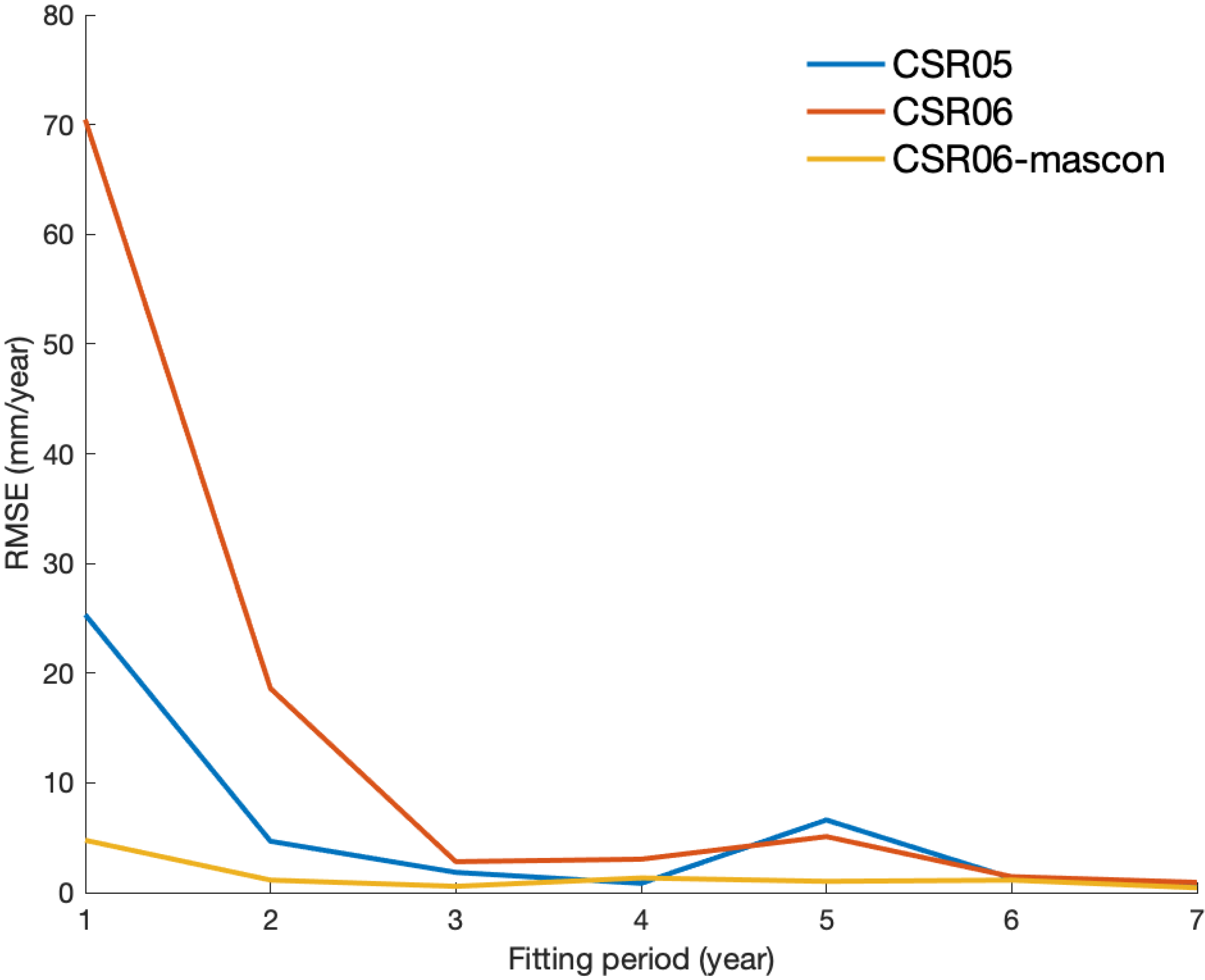
References
- Johnston, R.M.; Kummu, M. Water Resource Models in the Mekong Basin: A Review. Water Resour. Manag. 2012, 26, 429–455. [Google Scholar] [CrossRef]
- Hornerdevine, A.R.; Hetland, R.D.; Macdonald, D.G. Mixing and Transport in Coastal River Plumes. Annu. Rev. Fluid Mech. 2015, 47, 569–594. [Google Scholar] [CrossRef]
- Chen, S. Enhancement of Alongshore Freshwater Transport in Surface-Advected River Plumes by Tides. J. Phys. Oceanogr. 2014, 44, 2951–2971. [Google Scholar] [CrossRef]
- Hordoir, R.; Nguyen, K.D.; Polcher, J. Simulating tropical river plumes, a set of parametrizations based on macroscale data: A test case in the Mekong Delta region. J. Geophys. Res. 2006, 111. [Google Scholar] [CrossRef]
- Schiller, R.V.; Kourafalou, V.H. Modeling river plume dynamics with the HYbrid Coordinate Ocean Model. Ocean Model. 2010, 33, 101–117. [Google Scholar] [CrossRef]
- Moore, W.S.; Sarmiento, J.L.; Key, R.M. Tracing the Amazon component of surface Atlantic water using 228Ra, salinity and silica. J. Geophys. Res. Ocean 1986, 91, 2574–2580. [Google Scholar] [CrossRef]
- Moore, W.S.; Krest, J. Distribution of 223Ra and 224Ra in the plumes of the Mississippi and Atchafalaya Rivers and the Gulf of Mexico. Mar. Chem. 2004, 86, 105–119. [Google Scholar] [CrossRef]
- Xu, B.; Dimova, N.T.; Zhao, L.; Jiang, X.; Yu, Z. Determination of water ages and flushing rates using short-lived radium isotopes in large estuarine system, the Yangtze River Estuary, China. Estuar. Coast. Shelf Sci. 2013, 121, 61–68. [Google Scholar] [CrossRef]
- Chen, W.; Liu, Q.; Huh, C.-A.; Dai, M.; Miao, Y.-C. Signature of the Mekong River plume in the western South China Sea revealed by radium isotopes. J. Geophys. Res. 2010, 115. [Google Scholar] [CrossRef]
- Mccaul, M.; Barland, J.; Cleary, J.; Cahalane, C.; Mccarthy, T.J.; Diamond, D. Combining Remote Temperature Sensing with in-Situ Sensing to Track Marine/Freshwater Mixing Dynamics. Sensors 2016, 16, 1402. [Google Scholar] [CrossRef]
- Gordon, H.R.; Morel, A. Remote Assessment of Ocean Color for Interpretation of Satellite Visible Imagery: A Review; Springer: New York, NY, USA, 1983. [Google Scholar]
- Mullerkarger, F.E.; Mcclain, C.R.; Richardson, P.L. The dispersal of the Amazon’s water. Nature 1988, 333, 56–59. [Google Scholar] [CrossRef]
- Gao, S.; Wang, H.; Liu, G.; Li, H. Spatio-temporal variability of chlorophyll a and its responses to sea surface temperature, winds and height anomaly in the western South China Sea. Acta Oceanol. Sin. 2013, 32, 48–58. [Google Scholar] [CrossRef]
- He, Q.; Zhan, H.; Xu, J.; Cai, S.; Zhan, W.; Zhou, L.; Zha, G. Eddy-Induced Chlorophyll Anomalies in the Western South China Sea. J. Geophys. Res. 2019, 124, 9487–9506. [Google Scholar] [CrossRef]
- Loisel, H.; Mangin, A.; Vantrepotte, V.; Dessailly, D.; Dinh, D.N.; Garnesson, P.; Ouillon, S.; Lefebvre, J.P.; Meriaux, X.; Phan, T.M. Variability of suspended particulate matter concentration in coastal waters under the Mekong’s influence from ocean color (MERIS) remote sensing over the last decade. Remote Sens. Environ. 2014, 150, 218–230. [Google Scholar] [CrossRef]
- Loisel, H.; Vantrepotte, V.; Ouillon, S.; Ngoc, D.D.; Herrmann, M.; Tran, V.; Meriaux, X.; Dessailly, D.; Jamet, C.; Duhaut, T.; et al. Assessment and analysis of the chlorophyll-a concentration variability over the Vietnamese coastal waters from the MERIS ocean color sensor (2002–2012). Remote Sens. Environ. 2017, 190, 217–232. [Google Scholar] [CrossRef]
- Tapley, B.D.; Watkins, M.M.; Flechtner, F.; Reigber, C.; Bettadpur, S.; Rodell, M.; Sasgen, I.; Famiglietti, J.S.; Landerer, F.W.; Chambers, D.P. Contributions of GRACE to understanding climate change. Nat. Clim. Chang. 2019, 9, 358–369. [Google Scholar] [CrossRef]
- Alsdorf, D.; Lettenmaier, D.P. Tracking Fresh Water from Space. Science 2003, 301, 1491–1494. [Google Scholar] [CrossRef]
- Schmidt, R.; Schwintzer, P.; Flechtner, F.; Reigber, C.; Guntner, A.; Doll, P.; Ramillien, G.; Cazenave, A.; Petrovic, S.; Jochmann, H. GRACE observations of changes in continental water storage. Glob. Planet. Chang. 2006, 50, 112–126. [Google Scholar] [CrossRef]
- Wouters, B.; Bonin, J.A.; Chambers, D.P.; Riva, R.E.M.; Sasgen, I.; Wahr, J. GRACE, time-varying gravity, Earth system dynamics and climate change. Rep. Prog. Phys. 2014, 77, 41. [Google Scholar] [CrossRef] [PubMed]
- Ramillien, G.; Famiglietti, J.S.; Wahr, J. Detection of Continental Hydrology and Glaciology Signals from GRACE: A Review. Surv. Geophys. 2008, 29, 361–374. [Google Scholar] [CrossRef]
- Volkov, D.L.; Landerer, F.W. Nonseasonal fluctuations of the Arctic Ocean mass observed by the GRACE satellites. J. Geophys. Res. 2013, 118, 6451–6460. [Google Scholar] [CrossRef]
- Tregoning, P.; Lambeck, K.; Ramillien, G. GRACE estimates of sea surface height anomalies in the Gulf of Carpentaria, Australia. Earth Planet. Sci. Lett. 2008, 271, 241–244. [Google Scholar] [CrossRef]
- Wouters, B.; Chambers, D. Analysis of seasonal ocean bottom pressure variability in the Gulf of Thailand from GRACE. Glob. Planet. Chang. 2010, 74, 76–81. [Google Scholar] [CrossRef]
- Chen, Y.; Fok, H.S.; Ma, Z.; Tenzer, R. Improved Remotely Sensed Total Basin Discharge and its Seasonal Error Characterization in the Yangtze River Basin. Sensors 2019, 19, 3386. [Google Scholar] [CrossRef] [PubMed]
- Liu, Y.-C.; Hwang, C.; Han, J.; Kao, R.; Wu, C.-R.; Shih, H.-C.; Tangdamrongsub, N. Sediment-Mass Accumulation Rate and Variability in the East China Sea Detected by GRACE. Remote Sens. 2016, 8, 777. [Google Scholar] [CrossRef]
- Chen, J.L.; Wilson, C.R.; Li, J.; Zhang, Z. Reducing leakage error in GRACE-observed long-term ice mass change: A case study in West Antarctica. J. Geod. 2015, 89, 925–940. [Google Scholar] [CrossRef]
- Dobslaw, H.; Dill, R.; Bagge, M.; Klemann, V.; Boergens, E.; Thomas, M.; Dahle, C.; Flechtner, F. Gravitationally Consistent Mean Barystatic Sea Level Rise from Leakage-Corrected Monthly GRACE Data. J. Geophys. Res. Solid Earth 2020, 125. [Google Scholar] [CrossRef]
- Mu, D.; Xu, T.; Xu, G. Detecting coastal ocean mass variations with GRACE mascons. Geophys. J. Int. 2019, 217, 2071–2080. [Google Scholar] [CrossRef]
- Kummu, M.; Varis, O. Sediment-related impacts due to upstream reservoir trapping, the Lower Mekong River. Geomorphology 2007, 85, 275–293. [Google Scholar] [CrossRef]
- Cochrane, T.A.; Arias, M.E.; Piman, T. Historical impact of water infrastructure on water levels of the Mekong River and the Tonle Sap system. Hydrol. Earth Syst. Sci. 2014, 18, 4529–4541. [Google Scholar] [CrossRef]
- Dang, V.H.; Tran, D.D.; Pham, T.B.T.; Khoi, D.N.; Tran, P.H.; Nguyen, N.T. Exploring Freshwater Regimes and Impact Factors in the Coastal Estuaries of the Vietnamese Mekong Delta. Water 2019, 11, 782. [Google Scholar] [CrossRef]
- Xue, Z.; Liu, J.P.; Ge, Q. Changes in hydrology and sediment delivery of the Mekong River in the last 50 years: Connection to damming, monsoon, and ENSO. Earth Surf. Process. Landf. 2011, 36, 296–308. [Google Scholar] [CrossRef]
- Zhu, Y.; Fang, G.; Wei, Z.; Wang, Y.; Teng, F.; Qu, T. Seasonal variability of the meridional overturning circulation in the South China Sea and its connection with inter-ocean transport based on SODA2.2.4. J. Geophys. Res. Oceans 2016, 121, 3090–3105. [Google Scholar] [CrossRef]
- Quan, Q.; Xue, H.; Qin, H.; Zeng, X.; Peng, S. Features and variability of the South China Sea western boundary current from 1992 to 2011. Ocean Dyn. 2016, 66, 795–810. [Google Scholar] [CrossRef]
- Wu, W.; Wang, L.; Liao, Y.; Huang, B. Microbial eukaryotic diversity and distribution in a river plume and cyclonic eddy-influenced ecosystem in the South China Sea. MicrobiologyOpen 2015, 4, 826–840. [Google Scholar] [CrossRef]
- Rasanen, T.A.; Kummu, M. Spatiotemporal influences of ENSO on precipitation and flood pulse in the Mekong River Basin. J. Hydrol. 2013, 476, 154–168. [Google Scholar] [CrossRef]
- Da, N.D.; Herrmann, M.; Morrow, R.; Nino, F.; Huan, N.M.; Trinh, N.Q. Contributions of wind, ocean intrinsic variability and ENSO to the interannual variability of the South Vietnam Upwelling: A modeling study. J. Geophys. Res. 2019, 124, 6545–6574. [Google Scholar] [CrossRef]
- Save, H.; Bettadpur, S.; Tapley, B.D. High-resolution CSR GRACE RL05 mascons. J. Geophys. Res. Solid Earth 2016, 121, 7547–7569. [Google Scholar] [CrossRef]
- Save, H. CSR GRACE RL06 Mascon Solutions, Texas Data Repository, V1. 2019. Available online: https://doi.org/10.18738/T8/UN91VR (accessed on 12 March 2021).
- Bettadpur, S. Level-2 Gravity Field Product User Handbook; Center for Space Research the University of Texas at Austin: Austin, TX, USA, 2018. [Google Scholar]
- Chambers, D.P.; Bonin, J.A. Evaluation of Release-05 GRACE time-variable gravity coefficients over the ocean. Ocean Sci. 2012, 8, 859–868. [Google Scholar] [CrossRef]
- Dobslaw, H.; Flechtner, F.; Bergmann-Wolf, I.; Dahle, C.; Dill, R.; Esselborn, S.; Sasgen, I.; Thomas, M. Simulating high-frequency atmosphere-ocean mass variability for dealiasing of satellite gravity observations: AOD1B RL05. J. Geophys. Res. Oceans 2013, 118, 3704–3711. [Google Scholar] [CrossRef]
- Cheng, M.; Tapley, B.D. Variations in the Earth’s oblateness during the past 28 years. J. Geophys. Res. Solid Earth 2004, 109. [Google Scholar] [CrossRef]
- Swenson, S.; Chambers, D.; Wahr, J. Estimating geocenter variations from a combination of GRACE and ocean model output. J. Geophys. Res. Solid Earth 2008, 113, 08410. [Google Scholar] [CrossRef]
- Ries, J.B.; Bettadpur, S.; Eanes, R.; Kang, Z.; Ko, U.; McCullough, C.; Nagel, P.; Pie, N.; Poole, S.; Richter, T.; et al. The Combined Gravity Model GGM05C; GFZ Data Services: Potsdam, Germany, 2016. [Google Scholar]
- Swenson, S.; Wahr, J. Post-processing removal of correlated errors in GRACE data. Geophys. Res. Lett. 2006, 33. [Google Scholar] [CrossRef]
- Broerse, T.; Riva, R.; Simons, W.; Govers, R.; Vermeersen, B. Postseismic GRACE and GPS observations indicate a rheology contrast above and below the Sumatra slab. J. Geophys. Res. Solid Earth 2015, 120, 5343–5361. [Google Scholar] [CrossRef]
- Fok, H.S.; Zhou, L.; Liu, Y.; Ma, Z.; Chen, Y. Upstream GPS Vertical Displacement and its Standardization for Mekong River Basin Surface Runoff Reconstruction and Estimation. Remote Sens. 2020, 12, 18. [Google Scholar] [CrossRef]
- Moore, W.S.; Todd, J.F. Radium isotopes in the Orinoco estuary and eastern Caribbean Sea. J. Geophys. Res. Oceans 1993, 98, 2233–2244. [Google Scholar] [CrossRef]
- Bruner de Miranda, L.; Pinheiro Andutta, F.; Kjerfve, B.; de Castro Filho, B.M. Fundamentals of Estuarine Physical Oceanography; Springer: Singapore, 2017. [Google Scholar]
- Li, Z.; Zhang, C.; Ke, B.; Qiao, L.; Li, W.; Liu, Y. Inversion for sediment variation in the East China Sea using GRACE data. Chin. J. Geophys. Chin. Ed. 2019, 62, 2429–2440. [Google Scholar]
- Amarasekera, K.N.; Lee, R.; Williams, E.; Eltahir, E.A.B. ENSO and the natural variability in the flow of tropical rivers. J. Hydrol. 1997, 200, 24–39. [Google Scholar] [CrossRef]
- Fang, W.; Fang, G.; Shi, P.; Huang, Q.; Xie, Q. Seasonal structures of upper layer circulation in the southern South China Sea from in situ observations. J. Geophys. Res. 2002, 107, 3202. [Google Scholar] [CrossRef]
- Zu, T.; Wang, D.; Wang, Q.; Li, M.; Wei, J.; Geng, B.; He, Y.; Chen, J. A revisit of the interannual variation of the South China Sea upper layer circulation in summer: Correlation between the eastward jet and northward branch. Clim. Dyn. 2020, 54, 457–471. [Google Scholar] [CrossRef]
- Chen, C.; Wang, G. Interannual variability of the eastward current in the western South China Sea associated with the summer Asian monsoon. J. Geophys. Res. Oceans 2014, 119, 5745–5754. [Google Scholar] [CrossRef]
- Wang, C.; Wang, W.; Wang, D.; Wang, Q. Interannual variability of the South China Sea associated with El Niño. J. Geophys. Res. Oceans 2006, 111. [Google Scholar] [CrossRef]
- Zhou, H.; Yuan, D.; Li, R.; He, L. The western South China Sea currents from measurements by Argo profiling floats during October to December 2007. Chin. J. Oceanol. Limnol. 2010, 28, 398–406. [Google Scholar] [CrossRef]
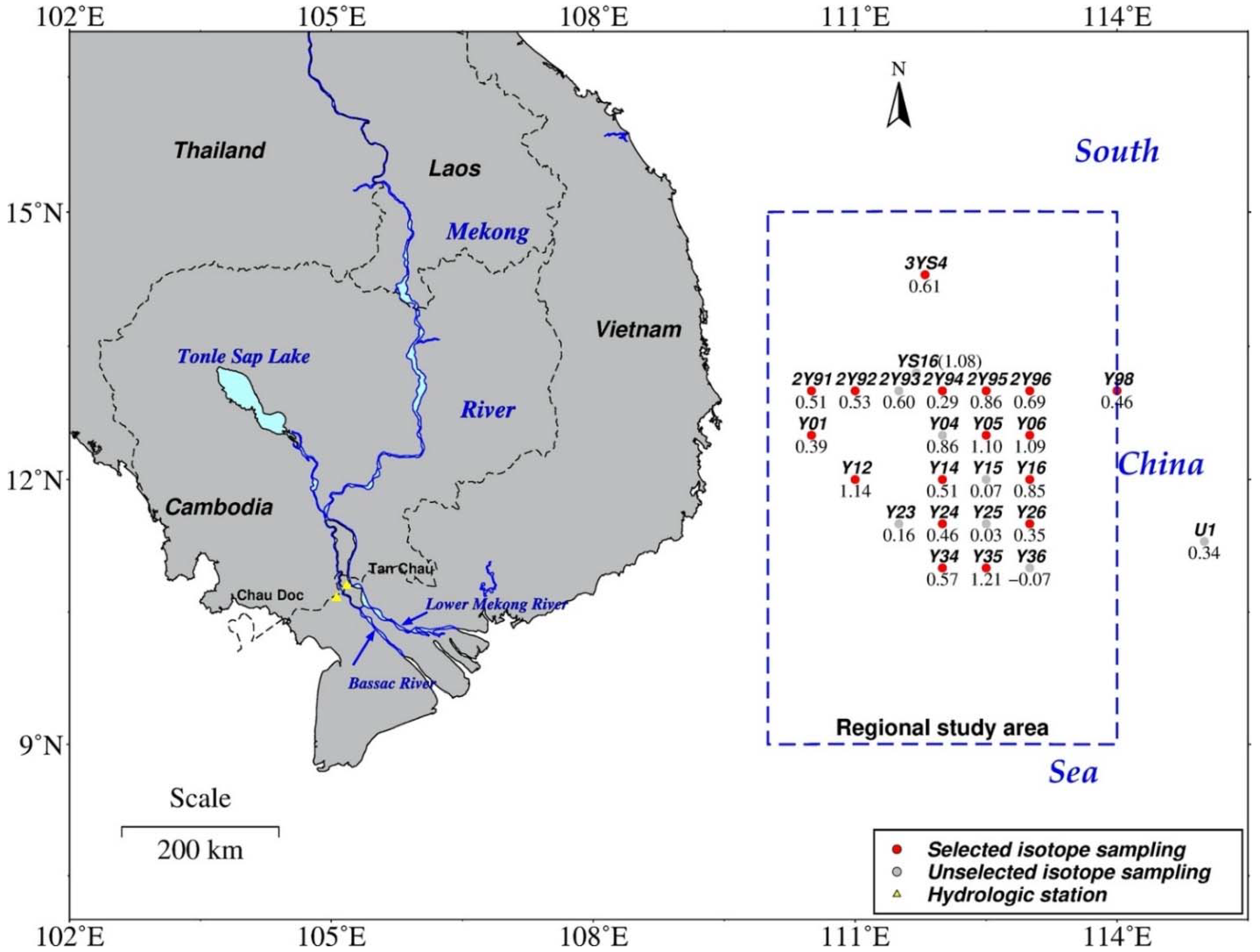
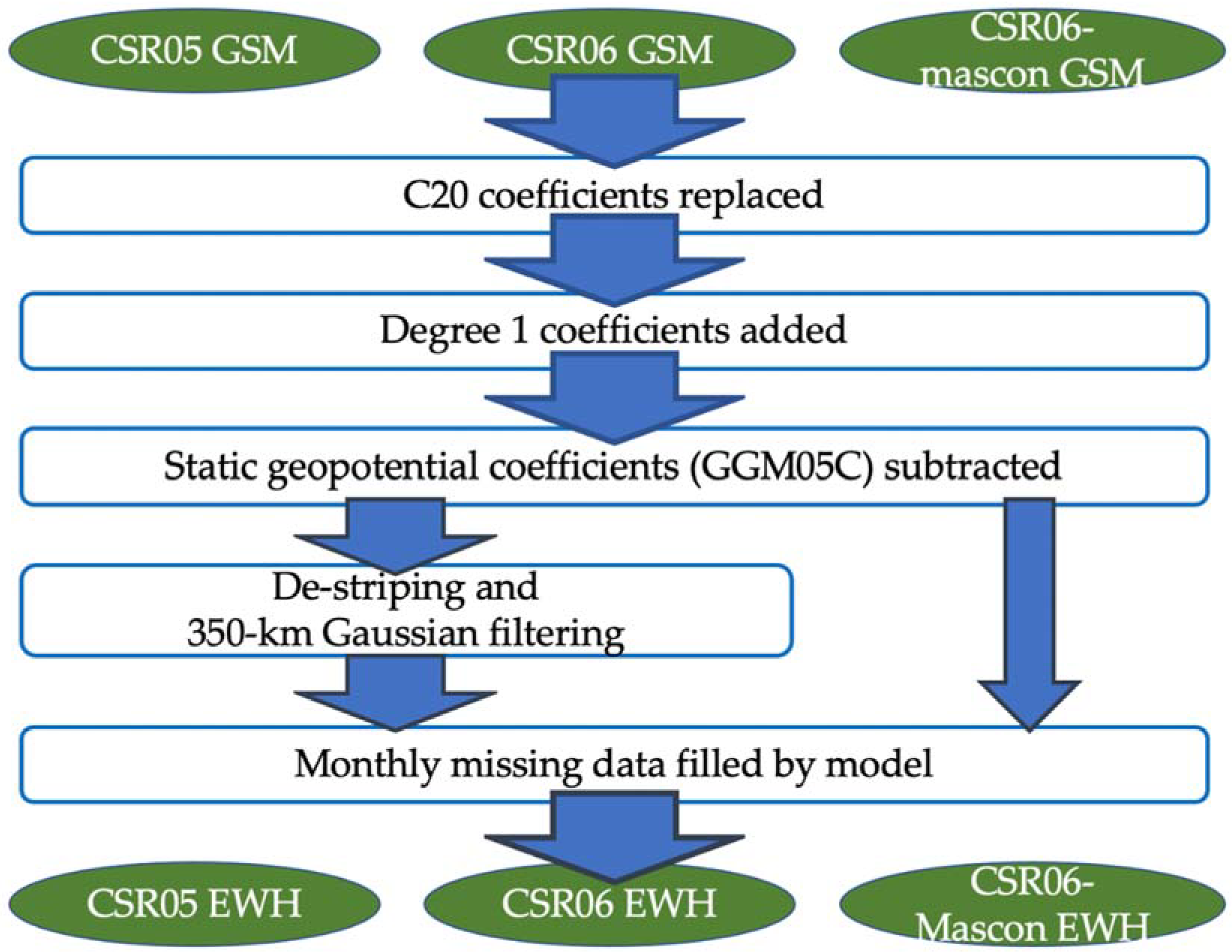

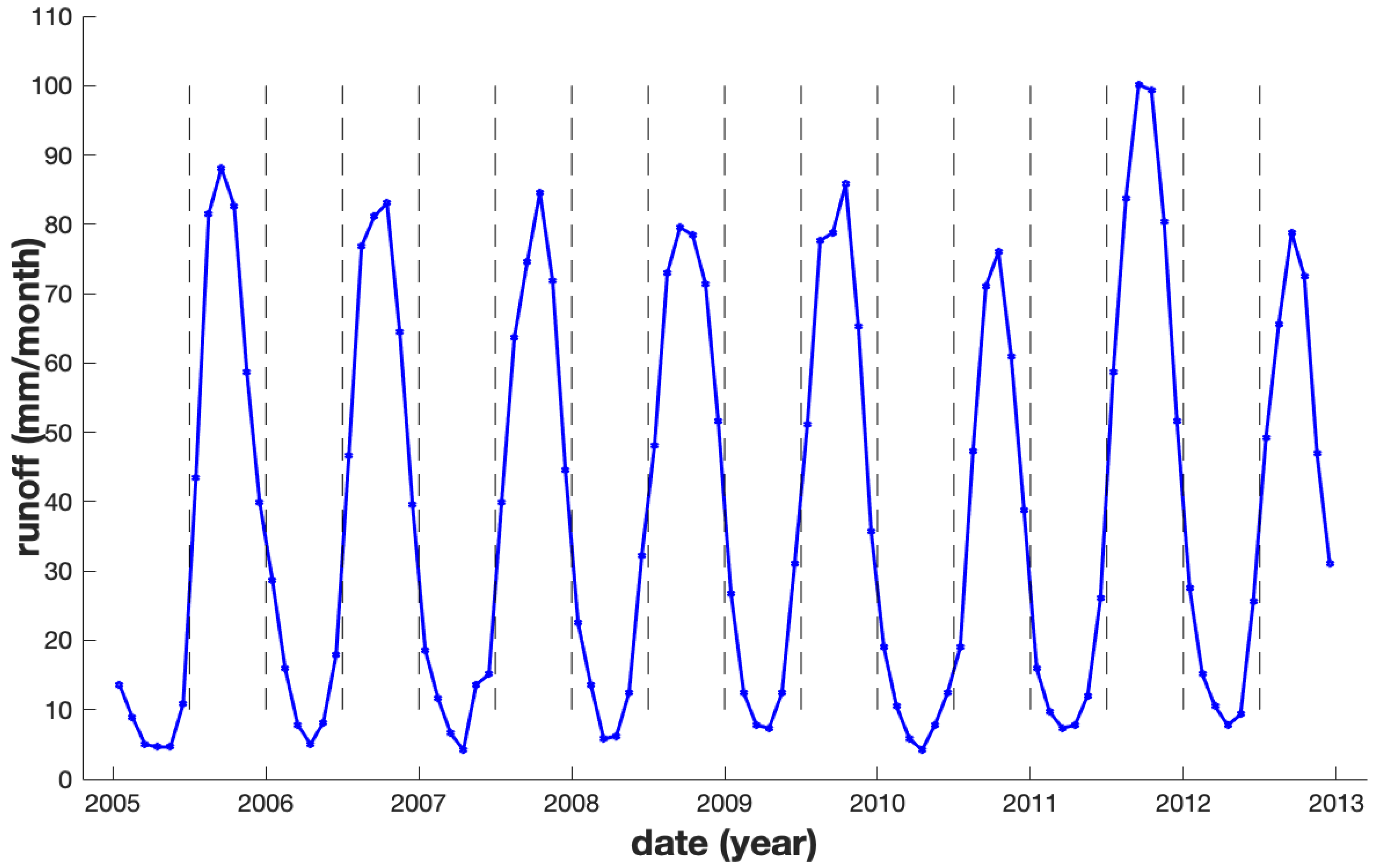
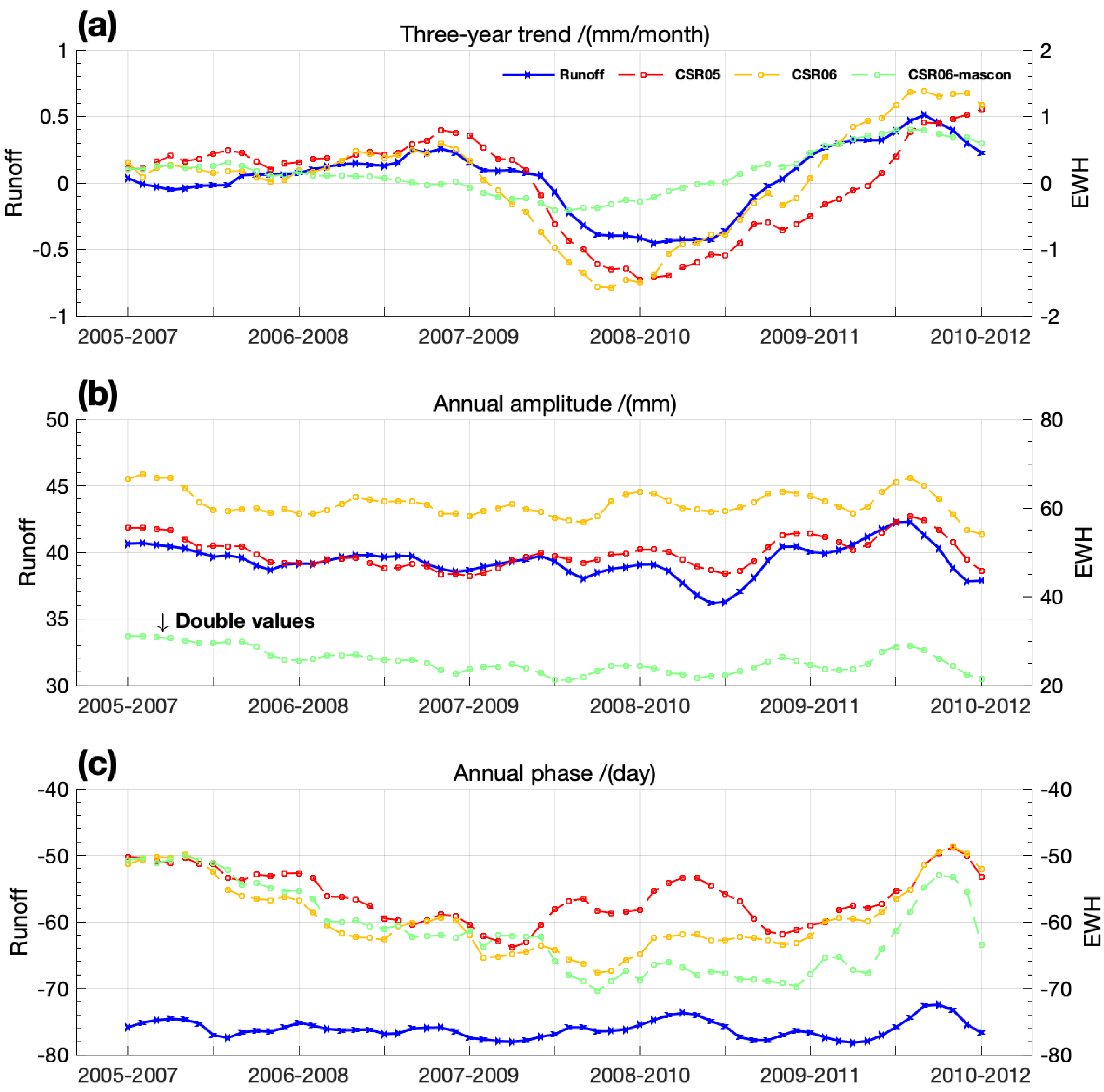
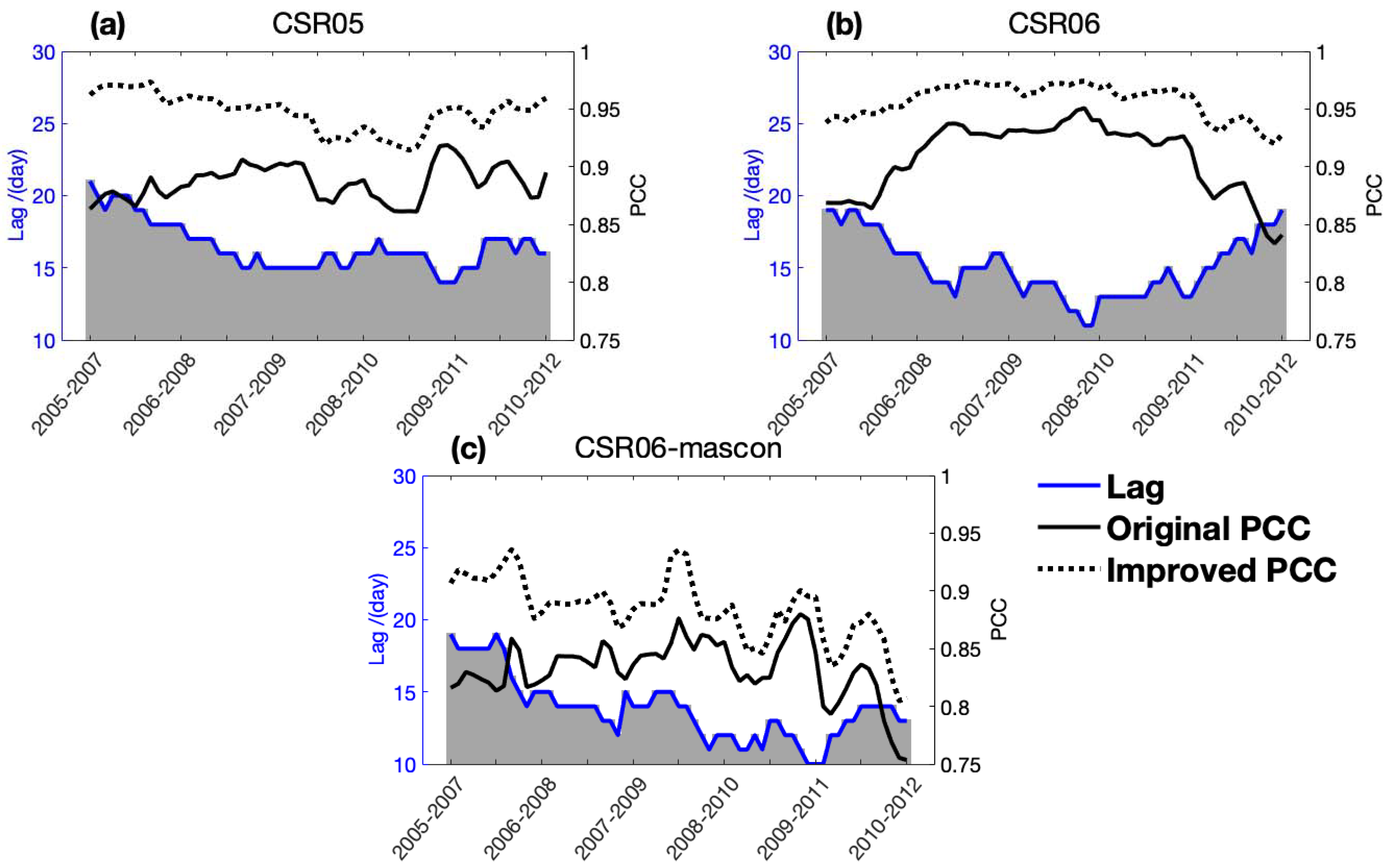
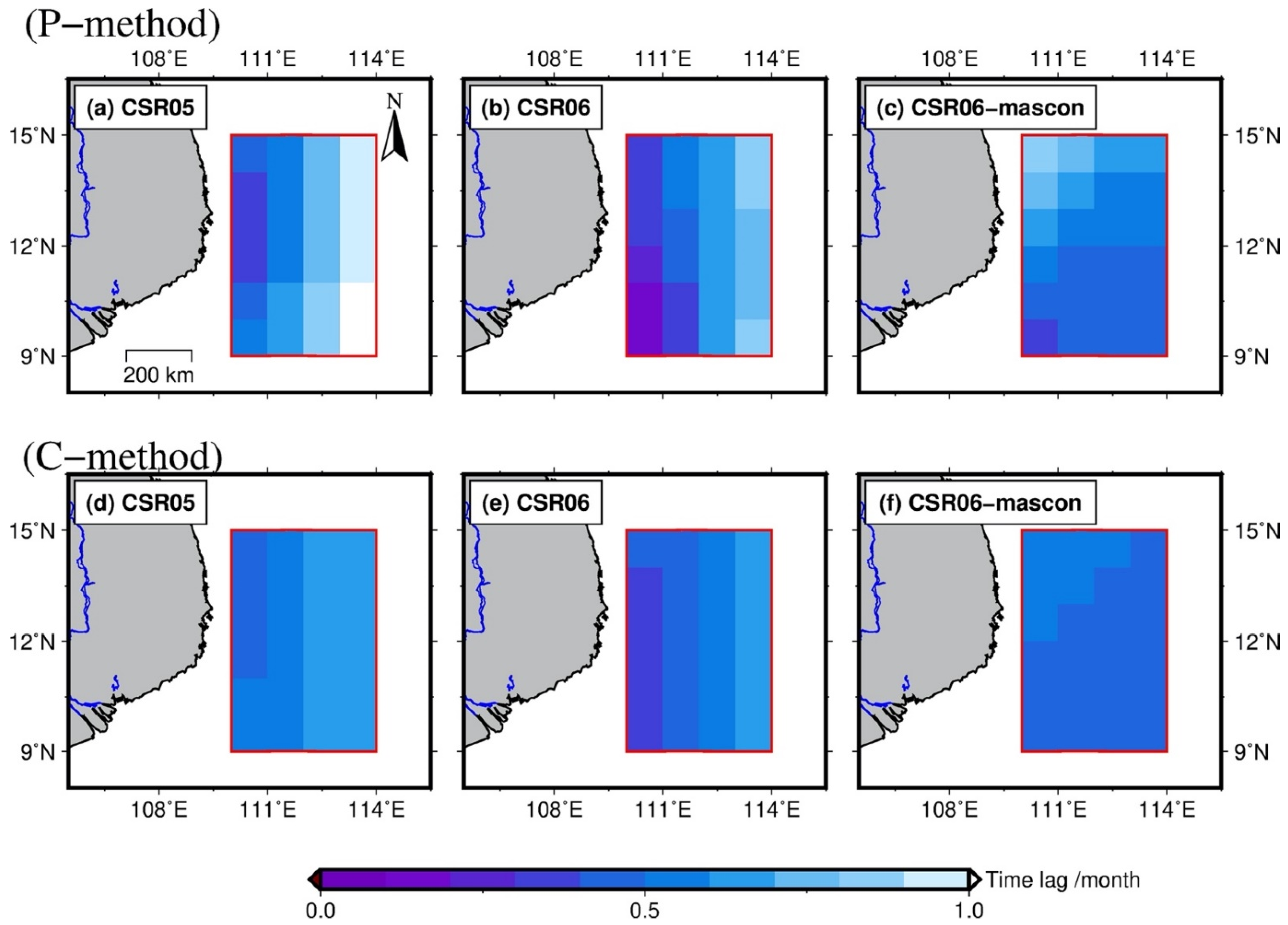

| Three-Year Trend (mm/month) | Annual Amplitude (mm) | Annual Phase (day) | Lag (day) | |||||
|---|---|---|---|---|---|---|---|---|
| PCC | STD | PCC | STD | PCC | STD | Mean | STD | |
| runoff | -- | 0.25 | -- | 1.23 | -- | 1.33 | -- | -- |
| CSR05 | 0.83 | 0.73 | 0.78 | 3.43 | 0.70 | 3.89 | 20 | 3.1 |
| CSR06 | 0.92 | 0.79 | 0.64 | 2.83 | 0.48 | 5.21 | 17 | 4.8 |
| CSR06-mascon | 0.71 | 0.34 | 0.66 | 1.36 | 0.35 | 6.23 | 15 | 5.9 |
| oPCC | iPCC | Lag (in days) | ||||
|---|---|---|---|---|---|---|
| Mean | STD | Mean | STD | Mean | STD | |
| CSR05 | 0.89 | 0.01 | 0.95 | 0.02 | 16 | 1.6 |
| CSR06 | 0.91 | 0.03 | 0.96 | 0.01 | 15 | 2.1 |
| CSR06-mascon | 0.83 | 0.03 | 0.88 | 0.03 | 14 | 2.2 |
| Estimation | Values | Lag Minus Age | |||
|---|---|---|---|---|---|
| Mean | STD | Mean | STD | ||
| Isotope-derived age | 0.68 | 0.29 | -- | -- | |
| GRACE-derived lag (P-method) | CSR05 | 0.71 | 0.19 | 0.03 | 0.32 |
| CSR06 | 0.58 | 0.15 | –0.11 | 0.31 | |
| CSR06-mascon | 0.56 | 0.09 | –0.13 | 0.33 | |
| GRACE-derived lag (C-method) | CSR05 | 0.59 | 0.09 | –0.10 | 0.30 |
| CSR06 | 0.50 | 0.07 | –0.18 | 0.29 | |
| CSR06-mascon | 0.46 | 0.02 | –0.22 | 0.30 | |
Publisher’s Note: MDPI stays neutral with regard to jurisdictional claims in published maps and institutional affiliations. |
© 2021 by the authors. Licensee MDPI, Basel, Switzerland. This article is an open access article distributed under the terms and conditions of the Creative Commons Attribution (CC BY) license (http://creativecommons.org/licenses/by/4.0/).
Share and Cite
Ma, Z.; Fok, H.S.; Zhou, L. GRACE-Derived Time Lag of Mekong Estuarine Freshwater Transport in the Western South China Sea Validated by Isotopic Tracer Age. Remote Sens. 2021, 13, 1193. https://doi.org/10.3390/rs13061193
Ma Z, Fok HS, Zhou L. GRACE-Derived Time Lag of Mekong Estuarine Freshwater Transport in the Western South China Sea Validated by Isotopic Tracer Age. Remote Sensing. 2021; 13(6):1193. https://doi.org/10.3390/rs13061193
Chicago/Turabian StyleMa, Zhongtian, Hok Sum Fok, and Linghao Zhou. 2021. "GRACE-Derived Time Lag of Mekong Estuarine Freshwater Transport in the Western South China Sea Validated by Isotopic Tracer Age" Remote Sensing 13, no. 6: 1193. https://doi.org/10.3390/rs13061193
APA StyleMa, Z., Fok, H. S., & Zhou, L. (2021). GRACE-Derived Time Lag of Mekong Estuarine Freshwater Transport in the Western South China Sea Validated by Isotopic Tracer Age. Remote Sensing, 13(6), 1193. https://doi.org/10.3390/rs13061193






